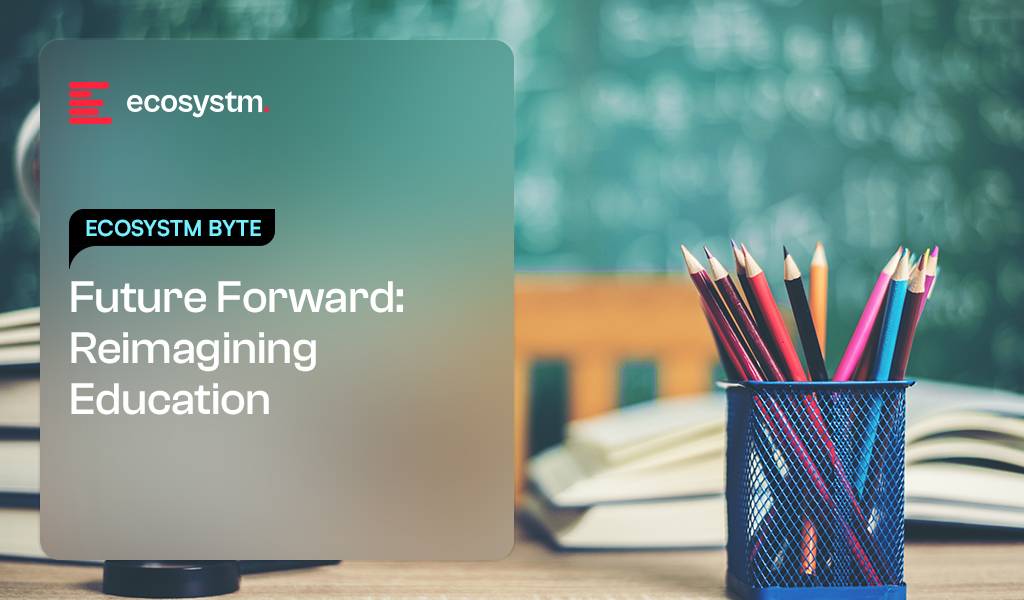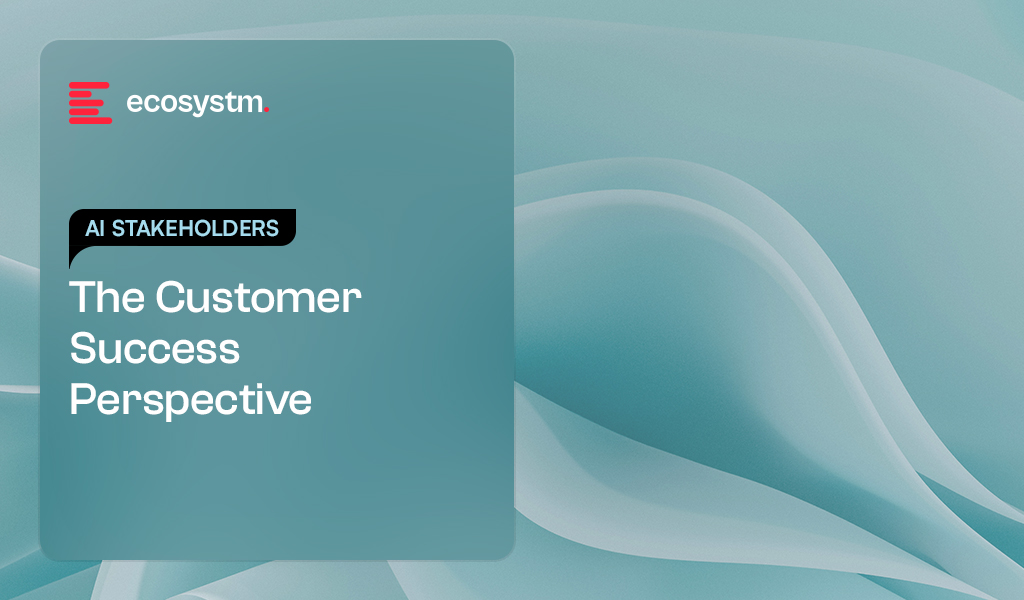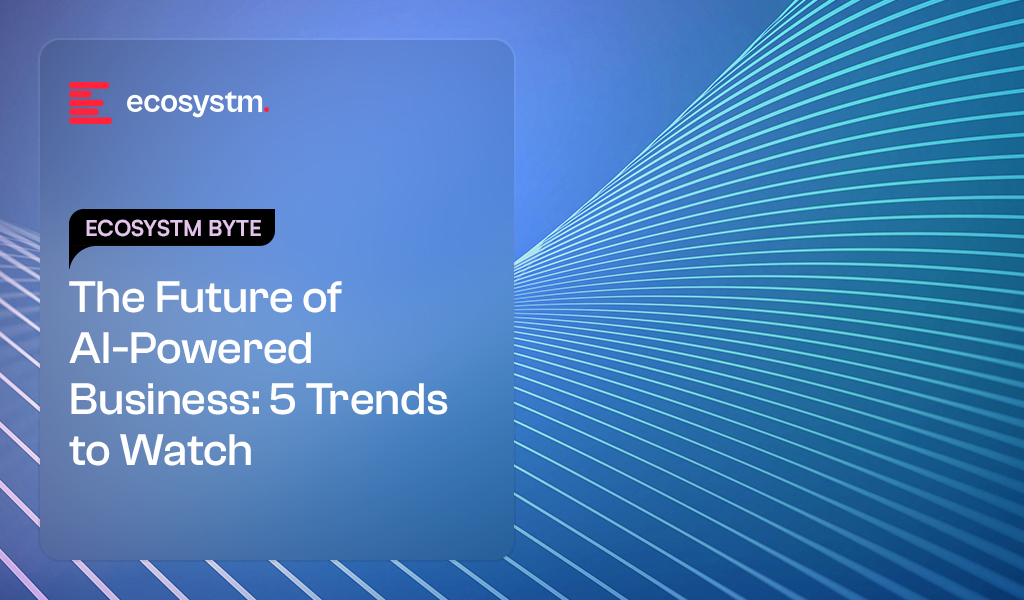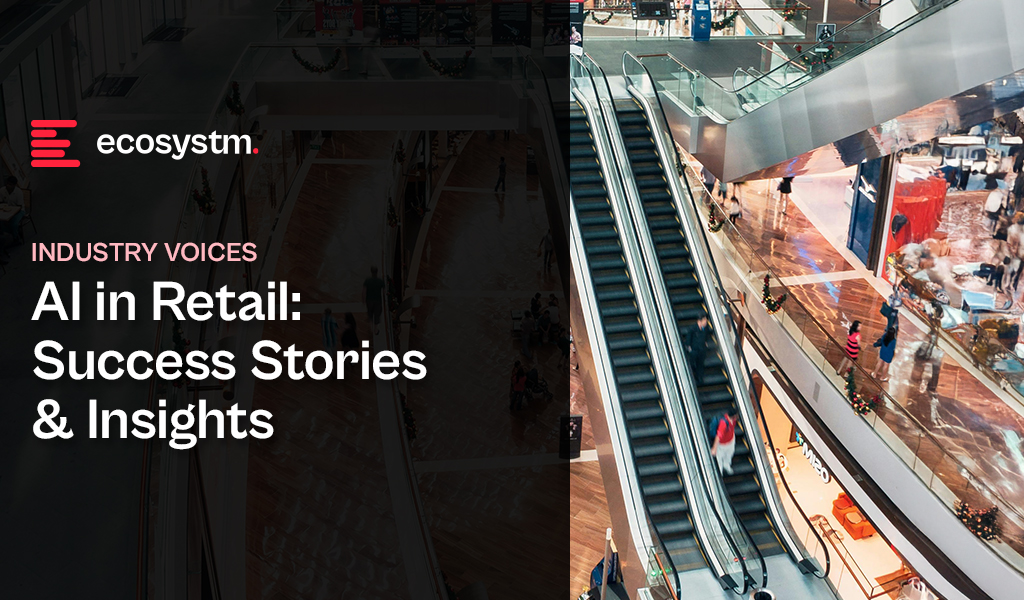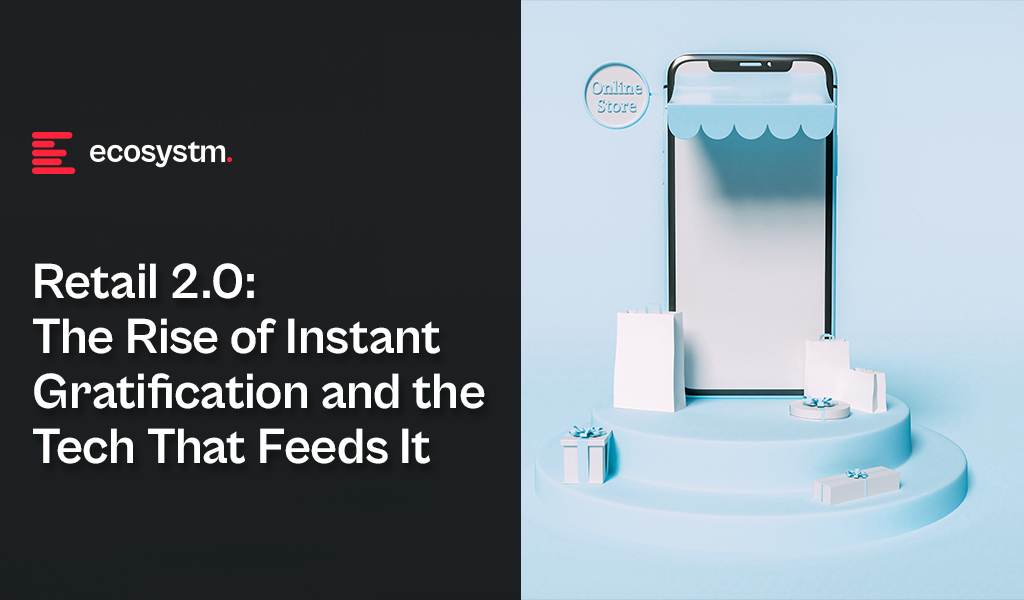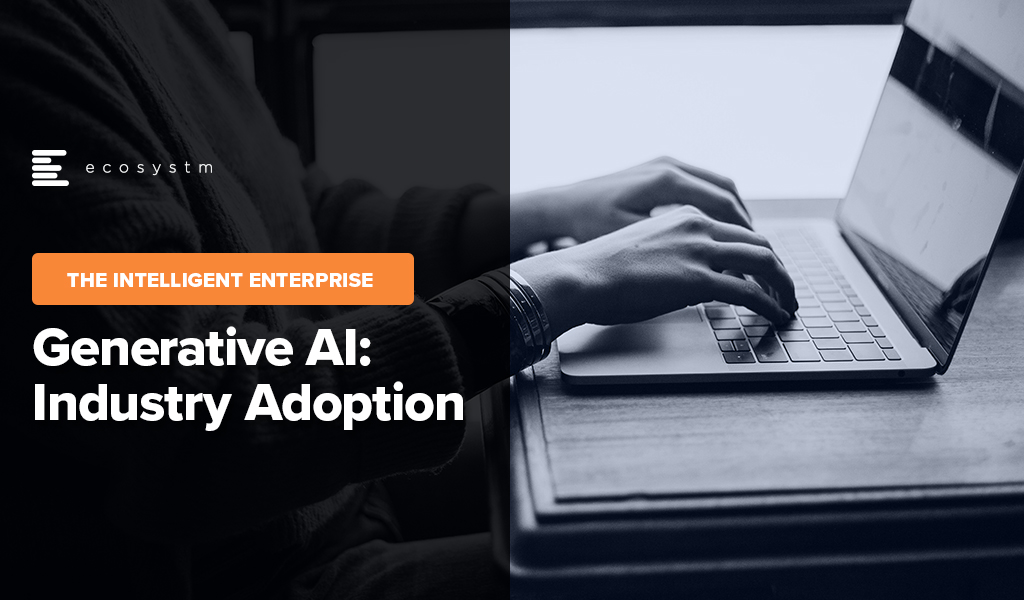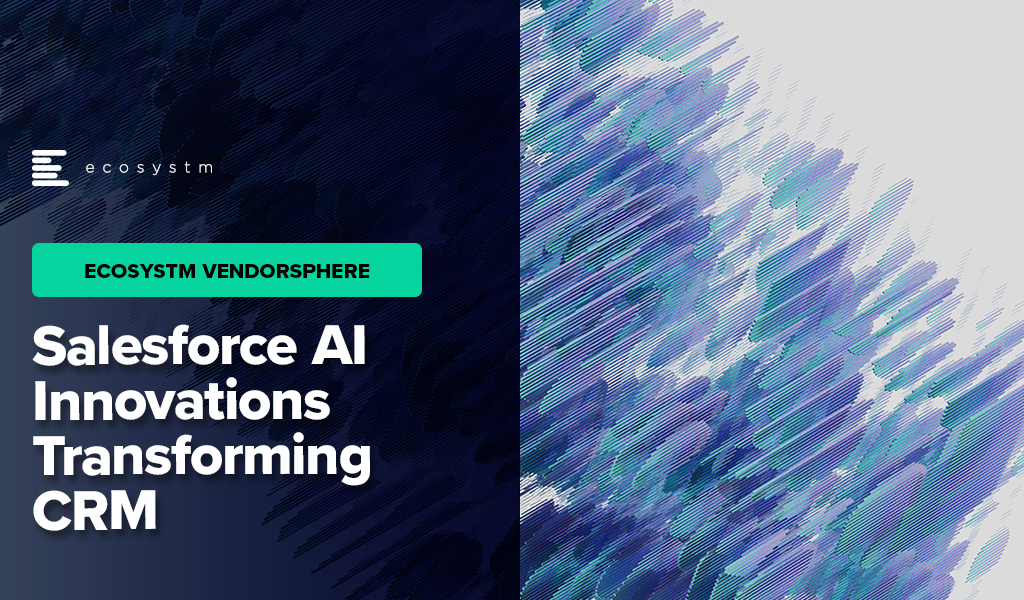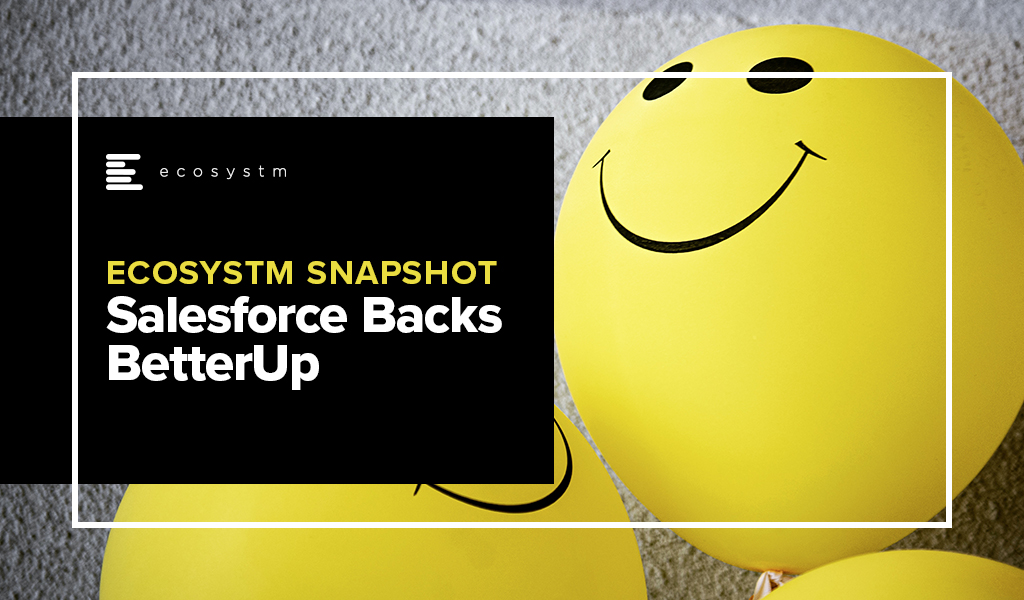The education sector is evolving rapidly, driven by technological innovation and shifting societal needs. This transformation extends beyond digitisation, requiring a fundamental rethink of how students and employees engage. AI-driven personalisation, immersive virtual environments, and data analytics are reshaping curricula, teaching strategies, and operational efficiency.

Here are recent examples of transformation across the Asia Pacific.
Click here to download “Future Forward: Reimagining Education” as a PDF.
Streamlining Service Delivery
Griffith University struggled with fragmented systems and siloed information, leading to inconsistent service and inefficiencies. Managing support for over 45,000 students became unsustainable, demanding a streamlined solution.
By adopting an enterprise service management platform, Griffith consolidated multiple portals into a single system, automating ticketing, request management, and AI-driven self-service.
Starting with library services, the transformation expanded across IT, HR, legal, and other functions, improving accessibility and collaboration. The impact was immediate: self-service surged by 87%, first-contact resolution jumped by 43%, and incident resolution time dropped by 25%. Call volume fell 31% and email inquiries 46%. Now scaling the platform university-wide, Griffith is streamlining service for students and staff.
AI for Recruitment & Content
The Indian Institute of Hotel Management (IIHM) sought to improve recruitment efficiency and enhance educational content creation. Manual hiring processes were slow and inconsistent, while developing high-quality learning materials was resource-intensive.
IIHM implemented an AI-driven platform to automate candidate assessments and generate accurate, engaging educational content.
This transformation cut interview times by half, improved hiring precision to 90%, and boosted student job placements by up to 30%. AI-generated materials reached 95% accuracy, creating a more effective learning experience. With stronger recruitment and enriched education, IIHM continues to reinforce its leadership in hospitality training.
AI-Accelerated Research
La Trobe University sought to harness GenAI to streamline research operations and accelerate market entry. Researchers faced challenges in accessing university-approved knowledge efficiently, while limited development capabilities slowed the commercialisation of research findings.
By implementing a retrieval-augmented generation (RAG) system, La Trobe enabled rapid, AI-powered access to research data, initially tested on autism studies.
Simultaneously, the university co-developed an AI-driven application to transform research into market-ready solutions faster. AI-driven development reduced time from months to weeks, with core components built in under a week. By leveraging in-house AI tools, La Trobe achieved an 8.7x cost reduction compared to outsourcing. This initiative positioned the university as a leader in AI-driven innovation, bridging the gap between academia and industry.
AI-Driven Personalisation
BINUS University aimed to future-proof its operations and student learning experiences. With GenAI reshaping education, the university sought to integrate AI into administration and teaching to boost efficiency and deliver adaptive, personalised learning.
BINUS has integrated AI across key areas, driving efficiency and personalisation.
AI-powered student intake predictions have reached 90% accuracy, optimising resource allocation across 14 campuses. GenAI automates Diploma Supplement Document (DPI) creation, reducing manual effort and improving accuracy. AI enhances the library system with personalised book recommendations and powers the AI Tutor for faster, tailored academic feedback. AI-driven language learning platforms further boost student engagement.
Unified Digital Workflows
Western Sydney University (WSU) faced inefficiencies from over 32 shared email addresses and paper-based forms, causing delays, poor inquiry tracking, and complicated administration – hindering timely, effective support.
WSU launched WesternNow to replace outdated systems with a unified digital platform, streamlining service requests, enhancing case tracking, cutting manual processes, and improving the user experience for students and staff.
This made WSU’s service delivery more responsive and efficient. The platform drastically improved efficiency, cutting request logging time from over 4 minutes to seconds. Staff tracked and resolved cases seamlessly without sifting through emails. Workflow digitisation eliminated most paper forms, saving time and resources, while consolidating forms into services reduced their number by 40%.

Customer Success leaders are keenly aware of AI’s burgeoning potential, and our latest research confirms it. AI is no longer a futuristic concept; it’s a present-day reality, already shaping content strategies for 55% of organisations and poised to expand its influence across a multitude of use cases.
Over the past two years, Ecosystm’s research – including surveys and deep dives with business and tech leaders – has consistently pointed to AI as the dominant theme.
Here are some insights for Customer Success Leaders from our research.
Click here to download “AI Stakeholders: The Customer Success Perspective” as a PDF.
AI in Action: Real-World Applications
The data speaks for itself. We’re seeing a significant uptake of AI in automating sales processes (69%), location-based marketing (63%), and delivering personalised product/service recommendations (61%). But beyond the numbers, what does this look like in practice?
In Marketing, AI tailors campaigns in real time based on customer behaviour, ensuring content and offers resonate. For e.g. in the Travel industry, AI analyses customer preferences to create customised itineraries, boosting satisfaction and repeat bookings. In Sales, AI-driven analysis of buying patterns helps teams stay ahead of trends, equipping them with the right products to meet demand. In Customer Experience, AI-powered feedback analysis identifies pain points before they escalate, leading to proactive problem-solving. We have already seen organisations using conversational AI to enable 24/7 customer engagement, instantly resolving issues while reducing team workload and enhancing CX.
Challenges and Opportunities: Navigating the AI Landscape
However, the path to AI adoption isn’t without its hurdles. Customer Success leaders face significant challenges, including the lack of an organisation-wide AI strategy, data complexity and access issues, and the cost of implementation.
Despite these challenges, the focus on AI to enhance Customer Success is evident, with nearly 40% of AI initiatives geared towards this goal. This requires a more active role for these leaders in shaping AI strategies and roadmaps.
Our research reveals that there lies a critical gap: Customer Success leaders have limited involvement in AI initiatives. Only 19% are involved in identifying and prioritising use cases, and a mere 10% have input into data ownership and governance. This lack of participation is a missed opportunity.
The 2025 Vision: AI-Driven Customer Success
Looking ahead, Customer Success leaders expect AI to deliver significant benefits, including improved customer experience (56%), increased productivity (50%), and enhanced innovation (44%). These expectations underscore AI’s pivotal role in shaping the future of customer success.
To fully harness AI’s potential and advancements like Agentic AI, leaders must take a more active role. This means driving a clear AI strategy, tackling data challenges, and working closely with IT and data science teams to ensure AI solutions address real customer pain points and business gaps.

The Asia Pacific region is rapidly emerging as a global economic powerhouse, with AI playing a key role in driving this growth. The AI market in the region is projected to reach USD 244B by 2025, and organisations must adapt and scale AI effectively to thrive. The question is no longer whether to adopt AI, but how to do so responsibly and effectively for long-term success.
The APAC AI Outlook 2025 highlights how Asia Pacific enterprises are moving beyond experimentation to maximise the impact of their AI investments.
Here are 5 key trends that will impact the AI landscape in 2025.
Click here to download “The Future of AI-Powered Business: 5 Trends to Watch” as a PDF.
1. Strategic AI Deployment
AI is no longer a buzzword, but Asia Pacific’s transformation engine. It’s reshaping industries and fuelling growth. Initially, high costs and complex ROI pushed leaders toward quick wins. Now, the game has changed. As AI adoption matures, the focus is shifting from short-term gains to long-term, innovation-driven strategies.
GenAI is is at the heart of this shift, moving beyond the periphery to power core business functions and deliver competitive advantage.
Organisations are rethinking AI investments, looking beyond pure financials to consider the impact on jobs, governance, and data readiness. The AI journey is about balancing ambition with practicality.
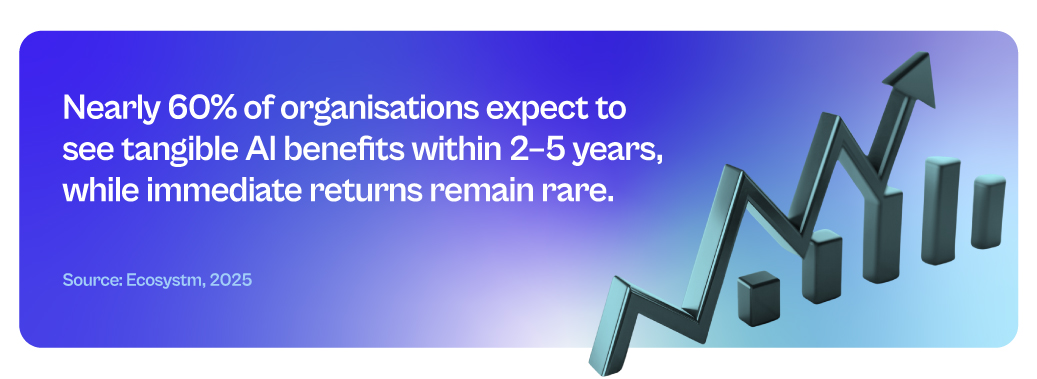
2. Optimising AI: Tailored Open-Source Models
Smaller, open-source, and specialised AI models will gain momentum as organisations seek efficiency, flexibility, and sustainability in their AI strategies.
Unlike LLMs, which require high computational power, smaller, task-specific models offer comparable performance while being more resource-efficient. This makes them ideal for organisations working with proprietary data or limited computational resources.
Beyond cost and performance, these models are more energy-efficient, addressing growing concerns about AI’s environmental impact.

3. Centralised Tools for Responsible Innovation
Navigating the increasingly complex AI landscape demands unified management and governance. Organisations will prioritise centralised frameworks to tame the chaos of diverse AI solutions, ensuring compliance (think EU AI Act) while boosting transparency and security.
Automated AI lifecycle management tools will streamline oversight, providing real-time tracking of model performance, usage, and issues like drift.
By using flexible developer toolkits and vendor-agnostic strategies, organisations can accelerate innovation while maintaining adaptability, as the technology evolves.
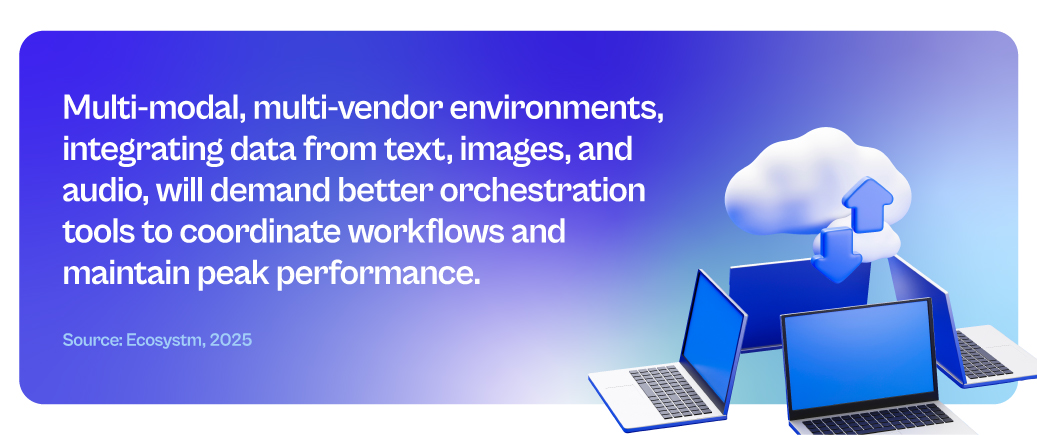
4. Supercharging Workflows With Agentic AI
Organisations will embrace Agentic AI to automate complex workflows and drive business value. Traditional automation tools struggle with real-world dynamism, but AI-powered agents offer a flexible solution. They empower autonomous task execution, intelligent decision-making, and adaptability to changing circumstances.
These agents, often using GenAI, understand complex instructions and learn from experience. They collaborate with humans, boosting efficiency, and adapt to disruptions, unlike rigid traditional automation.
Agentic workflows are key to redefining work, enabling agility and innovation.
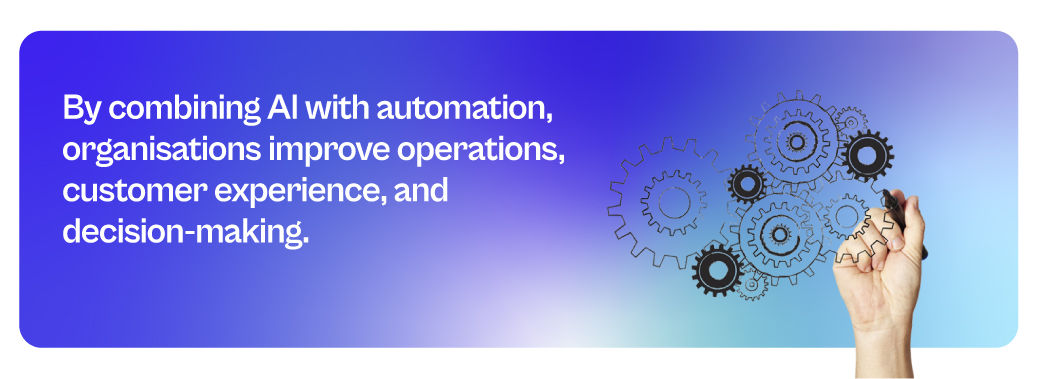
5. From Productivity to People
The focus of AI conversations will shift from simply boosting productivity to using AI for human-centric innovation that transforms both employee roles and customer experiences.
For employees, AI will handle routine tasks, enabling them to focus on creativity and innovation. Education and training will be crucial for a smooth transition to AI-powered workflows.
For customers, AI is evolving to offer more empathetic, personalised interactions by understanding individual emotions, motivations, and preferences. Organisations are recognising the need for transparent, explainable AI to build trust, tailor solutions, and deepen engagement.

Hit or miss AI experiments have leaders demanding results. In this breakneck AI landscape, strategy and realism are your survival tools. A pragmatic approach? High-impact, achievable goals. Know your capabilities, prioritise manageable projects, and stay flexible. The AI winners will be those who champion human-AI collaboration, bake in ethics, and never stop researching.

Over the past year, Ecosystm has conducted extensive research, including surveys and in-depth conversations with industry leaders, to uncover the most pressing topics and trends. And unsurprisingly, AI emerged as the dominant theme. Here are some insights from our research on the Retail industry.
Click here to download ‘AI in Retail: Success Stories & Insights’ as a PDF
From personalised product recommendations to predictive analytics, AI is helping retailers deliver exceptional customer experiences and optimise their operations. However, many retailers are still grappling with the complexities of AI implementation. Those who can successfully navigate this challenge and harness the power of AI will emerge as industry leaders, driving innovation and shaping the future of retail.

Despite the challenges, Retail organisations are witnessing early AI success in these 3 areas:
- 1. Customer Experience & Engagement
- 2. Supply Chain Optimisation
- 3. Fraud & Risk Analysis
Customer Experience & Engagement
- Conversational AI. Providing real-time customer support and answering queries
- Personalisation. Offering tailored product suggestions based on customer preferences and behaviour
- Virtual Try-On. Allowing customers to visualise products in different settings using AR
“AI has helped us to refine our customer chatbots to allow for more self-service. We’ve experienced faster customer order processing and quicker resolution of issues, putting control directly in the hands of our customers.” – CX LEADER
Supply Chain Optimisation
- Inventory Management. Automating inventory management processes to ensure optimal stock levels
- Supply Chain Visibility. Monitoring and optimising supply chain operations, including logistics and distribution
- Demand Forecasting. Predicting sales and demand trends to optimise inventory and production planning
“We use AI to optimise the supply chain, saving operational costs. Digital supply chains and cloud-based tracking systems streamline operations and enhance efficiency.” – CFO
Fraud & Risk Analysis
- Fraud Detection. Identify and prevent fraudulent activities, such as online fraud and chargebacks
- Risk Assessment. Assessing risk factors associated with customer transactions and preventing losses
- Customer & Market Insights. Understanding customer behaviour, market trends, and growth opportunities
“With eCommerce as a key market force, understanding customer habits is crucial to ensuring we have the right products in stock and optimising our pricing strategy.” – COO

Over a century ago, the advent of commercial flights marked a pivotal moment in globalisation, shrinking the time-distance between cities and nations. Less than a century later, the first video call foreshadowed a future where conversations could span continents in real time, compressing the space-distance between people.
The world feels smaller, not literally, but in how we experience space and time. Messages that once took days to deliver arrive instantly. Distances between cities are now measured in hours, not miles. A product designed in New York is manufactured in Shenzhen and reaches London shelves within weeks. In essence, things traverse the world with far less friction than it once did.
Welcome to The Immediate Economy!
The gap between desire and fulfilment has narrowed, driven by technology’s speed and convenience. This time-space annihilation has ushered in what we now call The Immediate Economy.
Such transformations haven’t gone unnoticed, at the click of a button is now a native (sort of cliché) expression. Amidst all this innovation, a new type of consumer has emerged – one whose attention is fleeting and easy to lose. Modern consumers have compelled industries, especially retail and ecommerce, to evolve, creating experiences that not only capture but also hold their interest.
Beyond Usability: Crafting a Memorable User Experience
Selling a product is no longer about just the product itself; it’s about the lifestyle, the experience, and the rush of dopamine with every interaction. And it’s all because of technology.
In a podcast interview with the American Psychological Association, Professor Gloria Mark from the University of California, Irvine, revealed a significant decline in attention spans on screens, from 150 seconds in 2004 to 40 seconds in the last five years. Social media platforms have spoiled the modern consumer by curating content that caters instantly to desires. Influence spills into the retail sector, compelling retailers to create experiences matching the immediacy and personalisation people now expect.
Modern consumers require modern retail experiences. Take Whole Foods, and their recent partnership with Amazon’s Dash Cart, transforming the mundane act of grocery shopping into a seamless dance of efficiency. Shoppers can now glide through aisles with carts that tally selections and debit totals directly from their accounts, rendering checkout lines obsolete. It’s more than convenience; it reimagines retail – a choreography of consumerism where every step is both effortless and calculated.
Whole Foods can analyse data from their Dash Cart technology to gain valuable insights into shopping patterns. The Immediate Economy revolutionises retail, transforming it into a hyper-efficient, personalised experience.
Retail’s new Reality: The Rise of Experiential Shopping
Just as Netflix queues up a binge-worthy series; retailers create shopping experiences as engaging and addictive as your favourite shows.
It’s been a financially rough year for Nike, but that hasn’t stopped them from expanding their immersive retail experience. Nike’s “House of Innovation” leverages 3D holographic tech. Customers can inspect intricate details of sneakers, including the texture of the fabric, the design of the laces, and the construction of the sole. The holographic display can also adjust to different lighting conditions and present the sneaker in various colours, providing a truly immersive and personalised shopping experience.
Fashion commerce platforms like Farfetch are among many integrating Virtual Try-On (VTO) technology. Leveraging the camera and sensors of customer devices, their AR technology overlays a digital image of a handbag onto a live view of a customer, enabling them to see how different styles and sizes would look on you. This approach to ecommerce enhances experiences, elevating interaction.
The 3D holographic display and the AR tech, are unique and visually appealing ways to showcase products, allowing customers to interact with products in a way that is not possible with traditional displays. Each shopping trip feels like the next episode of retail therapy.
The Evolution of Shopptertainment
The bar for quick content consumption is higher than ever thanks to platforms like TikTok and Instagram.
A prime example of this trend is Styl, a tech startup from two Duke students, with their “Tinder for shopping” application. Styl offers a swipeable interface for discovering and purchasing fashion items, seamlessly integrating the convenience and engagement of social media into the retail experience.
Styl goes beyond a simple swipe. By leveraging AI algorithms, it learns your preferences and curates a personalised feed of clothing items that align with your taste. Streamlining the shopping process, they deliver a tailored experience that caters to the modern consumer’s desire for convenience and personalisation.
Interestingly, Styl isn’t even a retail company; it pools items from websites, redirecting the users with relevant interest. They combine ecommerce with AI, creating the ultimate shopping experience for today’s customer. It’s fast, customised, and changing the way we shop.
Styl is not the first ones to do this, Instagram and TikTok provide individualised suggestions within their marketplace. But they differ by selling an experience, a vibe. That’s what sets them apart.

Tech-Powered Retail: The Heart of the Immediate Economy
History is filled with examples of societal innovation, but the Immediate Economy is transforming retail in exciting ways. In the 21st century, technology is both the catalyst and the consequence of the retail industry transformation. It began by capturing and fragmenting the average consumer’s attention, and now it’s reshaping consumer-brand relationships.
Today’s consumers crave personalised shopping. Whole Foods, with its AI-driven Dash Carts, is redefining convenience. Nike and Farfetch, through immersive AR and 3D tech, is making shopping an interactive adventure. Meanwhile, startups like Styl are leveraging AI to bring personalized fashion choices directly to consumers’ smartphones. The world is shrinking, not just in miles, but in the milliseconds it takes to satisfy a desire. From the aisles of Whole Foods to the virtual showrooms of Farfetch, The Immediate Economy offers an immersive world, where time and space bend to technology’s will, and instant gratification is no longer a perk; it’s an expectation. The Immediate Economy is here, and it’s changing how we interact with the world around us. Welcome to the future of retail, and everything else.

Generative AI is seeing enterprise interest and early adoption enhancing efficiency, fostering innovation, and pushing the boundaries of possibility. It has the potential of reshaping industries – and fast!
However, alongside its immense potential, Generative AI also raises concerns. Ethical considerations surrounding data privacy and security come to the forefront, as powerful AI systems handle vast amounts of sensitive information.
Addressing these concerns through responsible AI development and thoughtful regulation will be crucial to harnessing the full transformative power of Generative AI.
Read on to find out the key challenges faced in implementing Generative AI and explore emerging use cases in industries such as Financial Services, Retail, Manufacturing, and Healthcare.
Download ‘Generative AI: Industry Adoption’ as a PDF

Organisations are moving beyond digitalisation to a focus on building market differentiation. It is widely acknowledged that customer-centric strategies lead to better business outcomes, including increased customer satisfaction, loyalty, competitiveness, growth, and profitability.
AI is the key enabler driving personalisation at scale. It has also become key to improving employee productivity, empowering them to focus on high-value tasks and deepening customer engagements.
Over the last month – at the Salesforce World Tour and over multiple analyst briefings – Salesforce has showcased their desire to solve customer challenges using AI innovations. They have announced a range of new AI innovations across Data Cloud, their integrated CRM platform.
Ecosystm Advisors Kaushik Ghatak, Niloy Mukherjee, Peter Carr, and Sash Mukherjee comment on Salesforce’s recent announcements and messaging.
Read on to find out more.
Download Ecosystm VendorSphere: Salesforce AI Innovations Transforming CRM as a PDF

BetterUp, a mobile-based professional learning and wellness platform that connects employees with career experts recently raised USD 125 million Series D funding backed by Salesforce Ventures, in partnership with ICONIQ Capital, Lightspeed Venture Partners, Threshold Ventures, and Sapphire Ventures among others, bringing the company’s valuation to USD 1.73 billion. Previously in 2012, the company had raised USD 43 million in venture capital funding with an additional Series B funding of USD 30 million in March 2018. The BetterUp platform combines behavioural science, AI, and human interaction to enhance employees’ personal and professional well-being. Recently, the company also revealed two new products – Identify AI, to help organisations determine the right people to invest in and the appropriate coaching needed through the use of AI; and Coaching Cloud for customised training for frontline, professional, and executive employees.
This announcement comes on the back of several wins for BetterUp. To boost employee performance and organisational growth NASA and the Federal Aviation Administration (FAA) partnered with BetterUp to support new ways of coaching and preparing a workforce for change. The world’s largest brewer, AB InBev has partnered with BetterUp to strengthen diversity and inclusion through BetterUp’s coaching platform.
The Need to Improve Employee Experience
The pandemic changed the working arrangement of millions of employees and industries across the globe who are now working remotely or in a hybrid environment.
Ecosystm Principal Advisor, Audrey William says, “Driving better employee experience (EX) should take centre stage this year with enterprises putting employees at the centre of all initiatives. We will see EX platforms get integrated further and deeper into workplace collaboration and HR applications. In the last 12 months, we have seen apps monitoring wellness and sleep, training and coaching, meditation, employee motivation, and so on sit within larger collaboration platforms such as Slack, Zoom, Microsoft, Cisco and others.”
While the primary focus has been on optimising the work environment, it is time for organisations to start focusing on employee well-being. Ecosystm research shows that organisations implemented several measures to empower a remote workforce last year when the pandemic hit. But there was not enough focus on employee well-being (Figure 1).
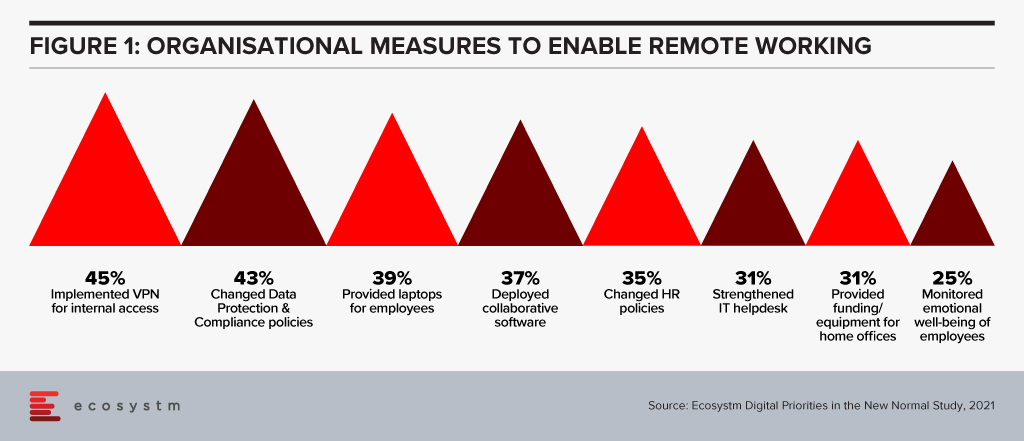
William says, “A hybrid work environment may have negative impact on your employees. You may face issues such as longer working hours, employee burnout, lesser social engagements and connection, loneliness – and mental and emotional issues and depression”.
“Organisations that place an emphasis on the employees will see their revenues grow and also see less attrition. The more you invest in your people, the more you will get back in return. It is as simple as that! You can see that now in some organisations where employees are being given more flexibility, employers are not dictating how they should work, diversity and inclusion efforts have become mainstream, and efforts are being made to make employees feel like they belong.”
William adds, “However, Ecosystm research finds that organisations have gone back to putting customers and business growth first – losing focus on their employees. Only 27% of organisations globally say that they have improving employee experience as a key business priority in 2021. It is time for this culture and mindset to change. And solutions such as BetterUp can make a difference.”
Transform and be better prepared for future disruption, and the ever-changing competitive environment and customer, employee or partner demands in 2021. Download Ecosystm Predicts: The top 5 Future of Work Trends For 2021.



